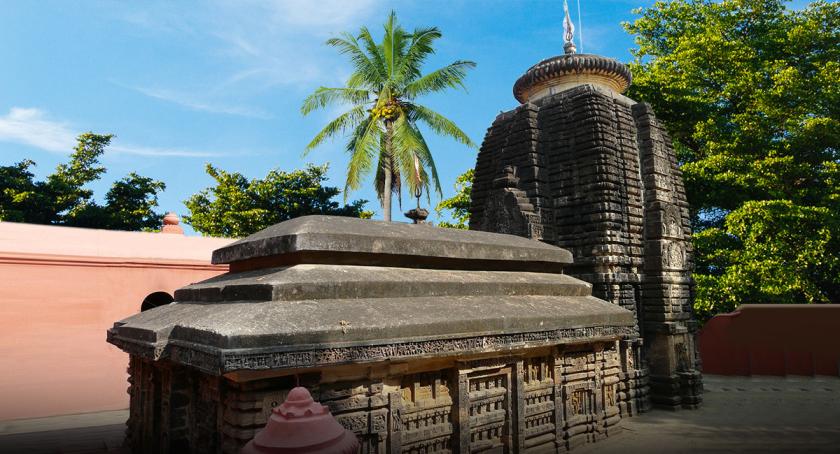Simhanath Temple, Cuttack
Simhanath Temple, located on an island in the Mahanadi River in Odisha’s Cuttack district, is a hidden gem of historical and spiritual significance. Dedicated to Lord Shiva, this ancient temple showcases the beautiful Kalinga architectural style, adorned with complex carvings and mythological depictions. Sage Kapila is believed to have meditated here in the 9th century, associating it with the divine power of Shiva as Simhanath, meaning “Lion Lord.” The temple’s serene riverfront location and deep-rooted cultural and religious importance make it a must-visit for devotees, history enthusiasts, and travelers alike.
This blog showcases the rich history, architectural brilliance, legends, and significance of Simhanath Temple, making it a must-visit site for travelers and spiritual seekers.
The Historical Significance of Simhanath Temple
Historians believe that the Simhanath Temple dates back to the 9th century AD, during the reign of the Somavamsi dynasty. Odisha experienced a flourishing temple-building tradition during this period, with architects constructing many architectural wonders to glorify Hindu deities. The temple is a testament to that era’s magnificence, representing the artistry and devotion of the artisans who built it.
The temple is closely associated with Hindu mythology and historical references, especially with Lord Shiva, who is worshipped here as Simhanath, meaning “the Lion God.” The name suggests strength and protection, attributes often linked to Lord Shiva. Additionally, historians believe that Sage Kapila, an essential figure in Hindu mythology, meditated at this temple, further enhancing its spiritual importance.
Besides its religious significance, the temple has also contributed to Odisha’s socio-cultural fabric, serving as a center for spiritual teachings and practices. Over the centuries, it has withstood time and natural elements, preserving its ancient essence and continuing to be a beacon of devotion for countless pilgrims.
Architectural Brilliance of Simhanath Temple
The Simhanath Temple is an outstanding example of Kalinga architecture, a distinctive architectural style that originated in Odisha. The temple’s design follows the classical elements of Kalinga architecture, featuring a rekha deul (curvilinear spire), exquisite carvings, and intricate sculptures that make it a marvel to behold.
Key Architectural Features:
- Vimana (Sanctum Sanctorum): The main sanctum of the temple, known as the vimana, is built in the traditional Kalinga style with a towering spire. This structure exudes grandeur with its striking vertical emphasis, complex carvings, and detailed ornamentation.
- Jagamohana (Assembly Hall): The jagamohana, or assembly hall, is an essential feature of Kalinga temples. In Simhanath Temple, this hall is adorned with beautifully sculpted pillars and decorative motifs, showcasing the artistic excellence of ancient Odishan sculptors.
- Intricate Sculptures and Carvings: The temple walls feature elaborate carvings of deities, celestial beings, and mythical creatures, reflecting the region’s rich artistic heritage. These sculptures depict various episodes from Hindu mythology, adding a storytelling aspect to the temple’s design.
- Riverfront Setting: One of the most striking features of the Simhanath Temple is its location. The temple is on an island in the Mahanadi River and offers a picturesque and serene environment. Because of its natural beauty, the temple is a tranquil haven for those looking for devotion and calm, heightening its spiritual atmosphere.
The Mythological Connection
Simhanath Temple is deeply rooted in Hindu mythology, with several fascinating legends adding to its mystical allure. These stories contribute to the temple’s religious significance and make it a revered site for devotees.
- The Simhanath Avatar of Lord Shiva: The name Simhanath translates to “Lion Lord,” representing a unique form of Lord Shiva that embodies strength and protection. This form of Shiva symbolizes divine power and attracts devotees seeking courage and spiritual enlightenment.
- Sage Kapila’s Meditative Retreat: According to legend, Sage Kapila, a revered sage in Hindu mythology, chose this site for his meditation. People say his presence infused the place with powerful spiritual energy, making it an ideal site for worship and meditation.
- Association with Narasimha: Some scholars suggest the temple may have historical connections with Lord Vishnu’s Narasimha (half-lion, half-man) incarnation. This possible connection adds another layer of religious significance to the temple, drawing devotees of both Shiva and Vishnu.
Religious and Cultural Significance
Simhanath Temple serves as a center for spiritual and cultural events and a place of worship. Devotees from across Odisha and beyond flock to the temple to seek blessings, especially during Maha Shivaratri, an enthusiastically celebrated festival. On this auspicious occasion, the temple glows with illuminated lamps as devotees offer prayers, perform rituals, and observe fasts to honor Lord Shiva.
The temple is essential for maintaining Odisha’s cultural legacy and religious significance. It reminds visitors of the region’s artistic and architectural prowess and attracts historians and scholars who study its complex designs and historical relevance.
Moreover, the temple is an ideal destination for those interested in ancient Indian temple architecture. Its blend of spiritual ambiance, historical depth, and artistic beauty makes it a perfect site for cultural tourism.
Why You Should Visit Simhanath Temple
Whether you are a devotee, a history enthusiast, or traveler looking for a serene retreat, Simhanath Temple offers something unique for everyone. Here’s why you should consider visiting:
- Spiritual Enlightenment: The temple’s sacred aura is perfect for meditation and devotion.
- Architectural Wonder: The complex carvings and stunning Kalinga architecture are a visual delight.
- Tranquil Setting: The temple on an island in the Mahanadi River provides a peaceful haven from the city’s bustle.
- Cultural Experience: Witnessing rituals and festivals at the temple provides insight into Odisha’s vibrant traditions.
- Photography and Exploration: The temple’s scenic beauty and architectural splendor make it an excellent spot for photography and exploration.
Conclusion
The Simhanath Temple of Odisha is a captivating blend of history, spirituality, and architecture, making it a must-visit destination for temple enthusiasts, historians, and devotees. Whether you seek divine blessings, wish to admire ancient artistry, or simply want to enjoy a tranquil escape amidst nature, this temple promises a unique and enriching experience.
Plan your visit to Simhanath Temple and delve into Odisha’s mystical past. Every stone has a story to tell!


